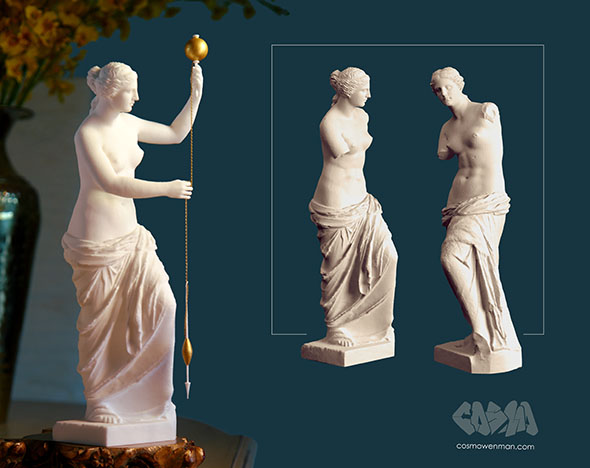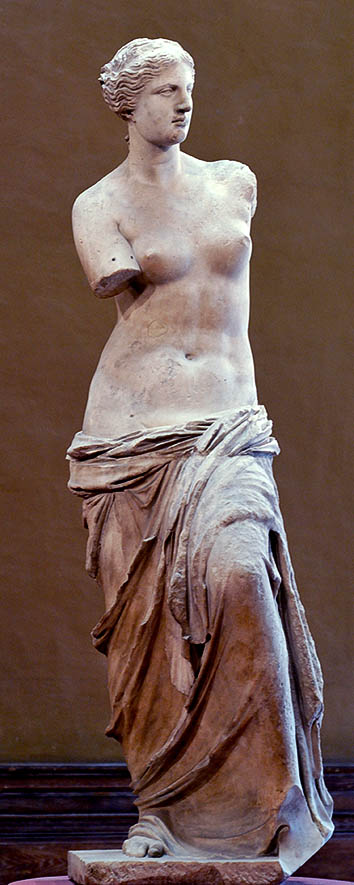What Was the Venus de Milo Doing With Her Arms?
3-D printing allows us to test a provocative theory that she was busy spinning thread.

Image courtesy of Cosmo Wenman
The Venus de Milo is a paradox: the embodiment of beauty, yet disfigured. And she is a puzzle, gazing serenely at something we cannot see, something once held, we assume, by her missing arms. “La Vénus de Milo est un mystère,” declared the French archaeologist Salomon Reinach in a 1890 essay, emphasizing the point with italics.
In Reinach’s day, speculation about the statue’s original pose was a minor industry. She was imagined standing beside a warrior—Mars or Theseus—with her left hand grazing his shoulder. She was pictured holding a mirror, an apple, or laurel wreaths, sometimes with a pedestal to support her left arm. She was even depicted as a mother holding a baby. One popular turn-of-the-century theory understood her not as Venus but as Victory, supporting a shield on her left thigh and recording the names of heroes on it with her right hand. Other versions imagined her using the shield as a mirror, the goddess of beauty admiring her reflection.
“No piece of statuary, no single work of art, has ever given rise to such controversy,” declared a 1902 essayist. Yet, he sighed, “in spite of the immense and constant interest shown in the subject, in spite of the bitter conflicts which have taken place upon the question, reconstruction of the Venus de Milo which shall satisfy everybody, or even a majority of critics, seems as far off as ever.”
Nearly two centuries after the statue’s discovery on the Greek island of Milos in 1820, we’ve simply gotten used to her armless state. The crowds of tourists who circle her in the Louvre, holding their cell phones aloft, experience the Venus as pure beauty, without the distracting symbolism of whatever she might have held. Her arms seem as superfluous as the earrings she once wore. She’s simply “the most gorgeous thing I’ve ever seen,” said the librarian when I checked out Disarmed, Gregory Curtis’s 2004 account of the 19th-century controversies surrounding the statue.
I certainly gave little thought to what might be missing when I admired her on trips to Paris. But reading Elizabeth Wayland Barber’s 1994 book Women’s Work: The First 20,000 Years made me wonder.
Barber, a professor emeritus at Occidental College and the doyenne of textile archeology, proffers a thesis the 19th-century critics never debated. She imagines Venus doing something that occupied endless hours of women’s time before the Industrial Revolution: spinning thread. She suggests that the statue held a distaff of fluffy fibers in her upraised left arm, while with her right she guided the thread toward a weighted drop spindle hanging in front of her. “This was a pose painfully familiar to women in ancient Greek society,” Barber notes.
It’s an appropriate metaphor for the goddess of love and reproduction. “Something new is coming into being where before there was at most an amorphous mass … Women create thread; they somehow pull it out of nowhere, just as they produce babies out of nowhere,” writes Barber.

Photo by Marie-Lan Nguyen/Creative Commons
For the ancient Greeks, spinning had yet another association with sex. Greek vases depict prostitutes spinning. It was a productive occupation while waiting for clients. “In the same manner that sex was the trade of the prostitutes, so too was the making of textiles,” writes art historian Rachel Rosenzweig in her 2004 book Worshipping Aphrodite.
So a spinning Venus seems theoretically plausible. But would the pose actually work? In the 19th century, a sculptor might have tested the idea with a plaster cast. In the 21st, we have a cheaper, simpler, more versatile option.
Cosmo Wenman is a San Diego designer and artist (and an old friend) who’s on a crusade to get museums to publicly release 3-D digital scans of their public-domain sculptures. One of his arguments for the social value of releasing scans is that they’d allow artists and others to remake existing works in imaginative ways.
Using his own scans, I knew that he’d restored the lost nose on the Louvre’s Inopos bust of Alexander the Great and had remixed elements of classical sculptures in a contemporary bust he’d done for a client. I also knew he had made a 3-D photocapture of the Venus from a highly accurate 1850 plaster cast now housed in the Skulpturhalle Basel in Switzerland.*
Cosmo had the know-how and the digital raw material to recreate Venus de Milo as a spinner. I hired him to try it.
Consulting Barber’s sketch, ancient images of spinning available online, and a YouTube tutorial on how to use a simple drop spindle, he worked with a digital anatomist to develop a 3-D rendering that preserved the statue’s existing pose intact. After a few iterations, the result was a convincing digital model.
We then hired the 3-D printing service Shapeways to make a tabletop replica in white plastic. (The tools had to be printed separately; some assembly required.) Turning the computer model into a tangible sculpture provided unexpected insights into the original. Cosmo quickly realized that neither the distaff and wad of fibers nor the spindle could have been made of marble. (“Maybe she lost her arms,” he quips, “because some dope did, in fact, put a 30-pound marble ball on the top of the distaff, and 20 pounds of extra weight from a solid marble spindle hanging on her right arm.”)
For our tabletop Venus, he imagined the tools instead as lightweight wood, painted gold. Rather than mundane wool thread, he used a gold chain appropriate for a goddess. The gold, he observes, also draws the modern viewer’s eye “away from the novelty of the arms, putting the viewer’s focus on the tools and the activity, where it would have been intended.”
The re-creation provides a plausible answer to a question posed by the original advocate of a spinning Venus, archeologist Elmer G. Suhr, in the 1950s and 1960s. Suhr identified many classical sculptures with poses suggestive of spinning, but none of them had implements. Where did the tools go? Suhr argued that “the equipment of a spinner must have been a disturbing element to the artist,” who simply dispensed with the distaffs and spindles, assuming that “everyone in ancient times was sufficiently familiar with the process” to recognize the stance and gestures. Cosmo’s version suggests a better answer: that the tools were separate accessories made of perishable materials or precious metals and have simply been lost or stolen.
None of this proves, of course, that the Venus de Milo was originally a spinner. (Citing a crudely carved hand holding an apple that was found on the same site, Curtis in his book argues for that theory; the poor carving, he suggests, is because the hand was meant to be mostly hidden against the wall of a niche.) But the replica demonstrates plausibility.
*Correction, May 1, 2015: This article originally misspelled the name of the Louvre’s Inopos bust of Alexander the Great. The article also misstated the technology artist Cosmo Wenman used to scan the Venus—he made a 3-D photocapture, not a laser scan. (Return.)